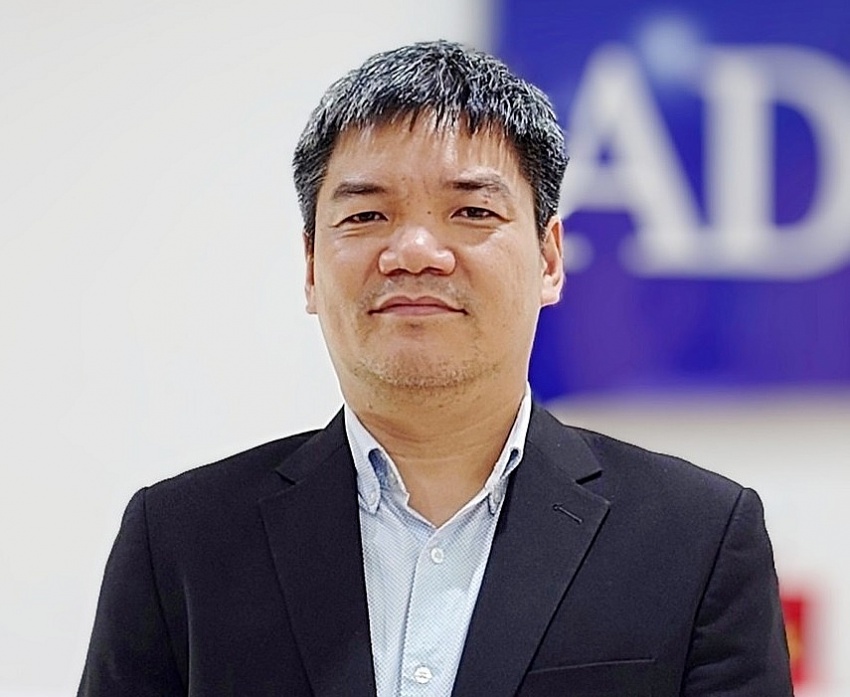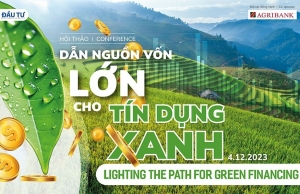Green finance development and promotion for Vietnam
What is your assessment of the role of green finance (GF) in Vietnam’s green growth strategy?
 |
| Nguyen Ba Hung, principal country economist from the Asian Development Bank in Vietnam |
GF plays a crucial role in Vietnam’s green growth strategy. Currently, this strategy has been enacted by the government, and Vietnam is in the process of detailing this strategy into action plans. In addition, Vietnam has also demonstrated its strong commitment to achieve net-zero emissions by 2050.
With this, investment capital flows to green sectors are expected to increase, with the support of international financial institutions. At the same time, banks and businesses have also been promoting loans and investment in green growth projects.
In fact, GF resources in Vietnam are relatively limited. The development of green banking activities at many credit institutions in Vietnam are still facing numerous challenges. However, the GF market still has a lot of potential for further development, especially GF products based on existing financial products such as green credit, green bonds, and green stocks. In addition, the carbon credit market, once established, will also create a channel for GF development.
More broadly, the GF trend in the world and the region has been growing exponentially in less than a decade, including through the pandemic. In addition to the emergence of green and sustainable financial products, legal regulations on environmental, social and governance (ESG) impact reporting in business operations has been developed in many markets, strengthening the bases for the GF market to continue to improve.
This shows that green and sustainable development in general, and the development of the green financial market in particular, are both an inevitable trend and a requirement that is gradually becoming urgent, and countries that deploy this early can take plenty of advantage from it.
Other countries lagging behind will take more time to access and comply with increasingly expanding and more complex regulations on ESG issues.
What opportunities can you see in the development of the GF market in Vietnam?
In terms of the legal framework, Vietnam is actively participating at the ASEAN regional level - where GF standards are already in place. Vietnam is an ASEAN member, and it can apply the region’s GF standards to its own legal frameworks to govern the domestic GF market. This is a great opportunity.
Among important regulations to promote green economy and GF is the criteria for the green economic activities, from which we can decide whether their financing green or not green. These green criteria need to be shaped by all players in the market, from capital users to capital providers. That is the next development that the market needs to do based on mandatory or voluntary frameworks.
From a market perspective, we can look at the current GF sources that Vietnam can access. There are relatively many external sources, coming from international organisations or foreign governments supporting climate change activities and green investment activities. Many green capital sources from abroad have significant incentives, which can become a driving force for the development of the GF market. In the world, finance mobilised through the market plays a major role, but less preferentially.
Meanwhile, domestic green capital sources are still limited, since the Vietnamese government still does not have dedicated capital for green investment to support green growth. Other financial sources in the market also do not have specific green requirements, so they have yet to create a strong motivation to develop the GF market. Furthermore, the national mechanism for carbon credit certification and market for carbon trade would also be a strong measure to open new opportunities for GF market development.
The most important thing is that the government develop an appropriate legal framework and create incentives for businesses and markets to promote GF.
The banking system plays a huge role in promoting green credit growth and managing environmental and social risks in credit granting activities. What is your take on the provision of green credit by commercial banks in Vietnam?
The banking system plays a substantial role in the GF market in Vietnam, and currently, a number of banks have been providing green credit to businesses. However, overall, the pace of such development is quite slow.
It is also important to note that in developing the GF market, in addition to the banking system, other channels of the capital market also need to be “greened”.
One of the main reasons is that banks and businesses lack incentives to lend and borrow green capital. When banks have their own green criteria, they will decide for themselves whether the activities of the borrowing enterprise are green or not, depending on whether the activities and projects of the enterprise are in line with the bank’s criteria.
In addition, if businesses have enough capacity to formulate their own green criteria in accordance with the law and ensure market reliability, they can proactively access green financial sources - including in the capital market such as green bonds. Banks, when providing capital according to business criteria, will also become GF providers. At this time, banks will be able to disburse green loans to businesses even if the bank does not have its own criteria.
However, it is necessary to understand that, compared to conventional financial markets, GF transactions must meet both credit standards and green criteria, meaning additional conditions are required, and costs could increase. So there needs to be some more incentives for enterprises to carry out green projects.
Some international financial institutions such as ADB have an active role and can provide green loans to the government, localities and businesses in Vietnam. For the 2021-2023 period, ADB has signed three green loans for businesses in Vietnam in the fields of solar power, wind power and electric vehicles.
Do you see any barriers in providing GF in Vietnam?
At present in Vietnam, developing the GF market has been one of the government’s priorities, and it has directly contributed to the government’s green development orientation. This means that in Vietnam, green lending and borrowing are not facing subjective barriers, and are even highly encouraged. However, the challenge in providing GF in Vietnam comes from the fact that it is difficult to do and motivation is lacking.
Firstly, developing GF markets would be in tandem with developing financial markets in general, especially capital markets. In Vietnam today, bank credit still plays a key role in the economy, so developing green banks is an important immediate requirement. In addition, other capital mobilisation channels in the market such as bonds and stocks also need to be “greened” during the development process.
Secondly, when it comes to the driving force for GF development, currently, not only in Vietnam but also in other countries, some banks and businesses use GF with benefits from marketing or branding, although they might not be mandatory compliance requirements. Meanwhile, the financial benefits could still be low.
In countries that have mandatory annual reporting in the areas of ESG, businesses must comply with reporting according to their own standards, or applicable regulatory standards, when they list on the exchange and attract investors and customers. If Vietnam has ESG standards for each specific sector, enterprises will have a concrete basis for implementation, and green credit providers can apply these standards before providing loans.
However, in Vietnam, there is regulations on the provision and receipt of GF, and there is no obligation to implement GF. Neither the supplier nor the recipient of green credits has any clear motivation and pressure on rights and obligations. That’s a big challenge.
What should the Vietnamese government do to develop the GF market, contributing to realising the commitment to achieve net-zero emissions by 2050?
To implement the net-zero commitment by 2050, Vietnam is developing financial mechanisms and policies to form and operate the domestic carbon market according to the provisions of the revised Law on Environmental Protection enacted in 2020. Under the government’s roadmap, the policies and mechanisms will be piloted from 2025, and the legal framework will be completed by 2027 before putting the carbon credit exchange into operation from 2028.
Establishing the carbon credit market will contribute to achieving the goal of reducing greenhouse gas emissions, promoting the application and development of low emission technologies, and improving the competitiveness of domestic enterprises, while heading towards developing a low-carbon economy and contributing to fight climate change.
Regarding the green financial market, the Vietnamese government needs to promulgate a clear legal framework, identify specific green criteria, and clarify what green responsibility is as well as accompanying rights, obligations, and incentives.
The general trend in the world is to start with the ability of businesses to self-assess the green level in their operations. When a business identifies their activities are green, the financial source for those activities will be eligible as GF.
Perhaps the most important factor is that the Vietnamese government needs to create incentives to develop the “green economy”, as a basis for the GF market. That is, it is possible to allocate a separate budget to promote the implementation of the country’s green goals, including supporting both credit providers and businesses to borrow green credit.
 | Green finance and management essential for sustainable future On November 22, the Vietnam Institute of Directors will hold its annual Corporate Management Forum and its Board of the Year awards. Chairwoman Ha Thu Thanh talked to VIR’s Thuy Linh about the current state of green finance and green management in Vietnam and inspirations for this year’s award. |
 | Green vision rises in finance-banking Experts are to shine a light on Vietnam’s efforts towards realising its committed green vision, particularly in the finance and banking sector. |
 | Central bank at the helm of shaping sustainable ambition With the requirement that socioeconomic development must go hand-in-hand with environmental protection and sustainable development, Vietnam is actively participating in international commitments on reducing greenhouse gas emissions and minimising the impact of climate change. |
What the stars mean:
★ Poor ★ ★ Promising ★★★ Good ★★★★ Very good ★★★★★ Exceptional
Related Contents
Latest News
More News
- From easy money to selective bets: investment prospects for Vietnam in 2026 (January 06, 2026 | 16:51)
- Stock market starts 2026 with growth and governance in focus (January 06, 2026 | 08:45)
- Cake by VPBank posts strong gains in scale and efficiency leveraging AI focus (January 05, 2026 | 18:55)
- Banks step up listing plans in 2026 to strengthen capital and transparency (December 31, 2025 | 18:59)
- Ho Chi Minh City projects $10.5 billion remittance inflows in 2025 (December 31, 2025 | 18:58)
- New decree sharpens enforcement in securities market (December 31, 2025 | 18:53)
- Gold market reform advances as SBV receives applications for bullion production (December 30, 2025 | 12:07)
- EVN and AFD sign credit agreement for Vietnam’s first pumped storage hydropower plant (December 30, 2025 | 10:06)
- Techcombank Priority Visa Signature unlocks a higher standard of living (December 29, 2025 | 16:44)
- Tax sector wraps up 2025 and sets priorities for next year (December 25, 2025 | 14:00)

 Tag:
Tag:


















 Mobile Version
Mobile Version